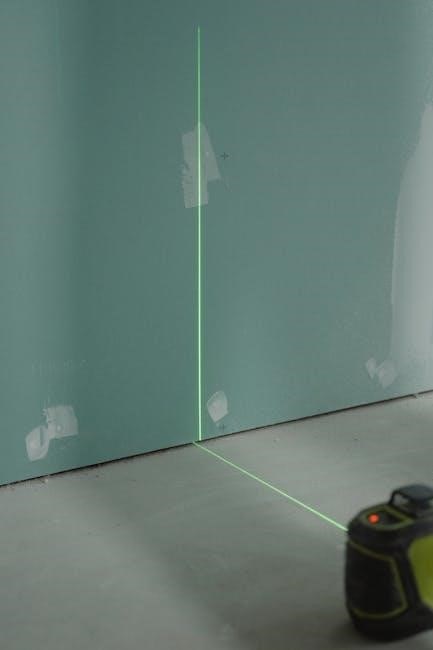Understanding tarp thickness is crucial for selecting the right cover for various needs. This guide explores the significance of thickness, materials, and applications to help you make informed decisions.
Whether for temporary covers, construction, or heavy-duty use, knowing the differences in tarp thickness ensures durability, weather resistance, and cost-effectiveness. Discover how to choose the perfect tarp for your tasks.
Understanding the Importance of Tarp Thickness
Tarp thickness plays a vital role in determining durability, weather resistance, and suitability for specific tasks. Thicker tarps, measured in mils, offer greater strength and longevity, making them ideal for heavy-duty applications. Lighter tarps, while less durable, are more portable and cost-effective for temporary use. Understanding the importance of tarp thickness helps ensure you select the right cover for your needs, preventing damage and extending the lifespan of your tarp. This guide will help you navigate the options, ensuring you make an informed decision for your specific requirements.
Overview of Tarp Materials and Their Thickness
Tarps are made from various materials, each offering distinct thickness and durability. Polyethylene tarps are the most common, lightweight, and waterproof, typically ranging from 5 to 24.8 mils. Vinyl tarps are heavier and more durable, often used in industrial settings, with thicknesses from 10 to 57.5 mils. Both materials are measured in mils, with higher numbers indicating greater thickness and strength. Understanding the material and its thickness helps in selecting the right tarp for specific needs, ensuring optimal performance and longevity in various applications.
Defining Tarp Thickness
Tarp thickness is measured in mils (one-thousandth of an inch), indicating the material’s strength and durability. Higher mil ratings mean thicker, more robust tarps for heavy-duty applications.
What Are Mils and How Are They Measured?

Mils measure tarp thickness in thousandths of an inch, with higher values indicating thicker, more durable tarps. Mils are measured using specialized tools like calipers or micrometers, ensuring accuracy. This unit is crucial for assessing a tarp’s strength, durability, and suitability for specific tasks. Lightweight tarps typically range from 5-8 mils, while heavy-duty options exceed 20 mils. Understanding mil measurements helps users select the right tarp for their needs, ensuring long-lasting performance and reliability across various applications.
Common Thickness Ranges for Tarps
Tarps are categorized by thickness, typically measured in mils (1/1,000 of an inch). Light-duty tarps range from 5-8 mils, ideal for temporary or light-use applications. Medium-duty tarps, at 10-12 mils, offer greater durability for everyday tasks. Heavy-duty tarps range from 14-20 mils, suitable for construction or outdoor use, while super heavy-duty tarps exceed 20 mils, providing maximum strength for industrial or extreme conditions. Each thickness range is designed to meet specific demands, ensuring optimal performance and longevity for various applications.

Tarp Thickness Categories

Tarps are categorized into four main thickness groups: Light-Duty (5-8 mils), Medium-Duty (10-12 mils), Heavy-Duty (14-20 mils), and Super Heavy-Duty (20+ mils), each designed for specific applications.
Light-Duty Tarps (5-8 mils)
Light-duty tarps, ranging from 5 to 8 mils, are ideal for temporary or short-term use. These tarps are lightweight, easy to handle, and suitable for mild weather conditions. They are often used for covering small items, providing shade, or as disposable covers. Despite their thinness, they offer basic water resistance and UV protection, making them a cost-effective solution for everyday tasks. However, they may not withstand heavy winds or prolonged exposure to harsh weather, making them best for light applications where durability is not a primary concern.
Medium-Duty Tarps (10-12 mils)
Medium-duty tarps, measuring 10-12 mils, offer enhanced durability and versatility for a variety of applications. They are suitable for outdoor events, light construction projects, and covering furniture or equipment. These tarps provide better resistance to weather conditions, including UV exposure and moderate winds, compared to lighter options. Their balanced weight and strength make them ideal for short-term to medium-term use. While not as heavy as industrial-grade tarps, they are a reliable choice for general-purpose tasks, offering a good mix of affordability and performance for everyday needs.
Heavy-Duty Tarps (14-20 mils)
Heavy-duty tarps, ranging from 14-20 mils, are designed for demanding applications requiring durability and strength. These tarps are ideal for construction sites, industrial use, and long-term outdoor protection. Their thicker material provides excellent resistance to harsh weather, heavy loads, and potential punctures. With superior UV and water resistance, they are a reliable choice for extended use. The increased thickness ensures longevity, making them a cost-effective solution for heavy-duty tasks, despite being more expensive than lighter options. They are a preferred choice for professionals needing robust protection in challenging environments.
Super Heavy-Duty Tarps (20+ mils)
Super heavy-duty tarps, exceeding 20 mils, are the thickest and most robust options available. Designed for extreme conditions and heavy industrial use, they offer unparalleled durability and resistance to weather, abrasion, and heavy loads. These tarps are commonly used in transportation, heavy construction, and long-term outdoor storage. Their exceptional thickness ensures minimal wear and tear, making them ideal for prolonged exposure to harsh environments. Despite their higher cost, they provide long-lasting protection, making them a wise investment for demanding applications where lesser tarps would fail. Their superior strength and reliability set them apart as the ultimate choice for heavy-duty needs.


Factors Influencing Tarp Thickness
Tarp thickness is influenced by material type, weight, and durability needs. Polyethylene and vinyl tarps vary in thickness, impacting their strength and suitability for different applications.
Material Types (Polyethylene, Vinyl, etc.)
Polyethylene tarps are the most common, offering lightweight, waterproof, and UV-resistant properties, typically ranging from 5 to 24 mils. Vinyl tarps are heavier, more durable, and ideal for heavy-duty use. They are often thicker, with a smoother surface, making them resistant to abrasion and chemicals; Other materials include canvas and polyester, each with unique thickness and durability profiles. The choice of material directly impacts the tarp’s thickness, weight, and suitability for specific tasks, ensuring optimal performance in various environments and applications.
Weight and Durability Considerations
Tarp weight, measured in ounces per square yard, directly correlates with thickness and durability. Thicker tarps, such as those above 20 mils, are heavier and more robust, suitable for harsh conditions. Lightweight options (5-8 mils) are ideal for temporary use but may not withstand heavy stress. Higher weight tarps, like 18 oz (21.3 mils), offer enhanced strength and longevity, making them perfect for industrial or construction settings. Balancing weight and thickness ensures the tarp meets specific demands without compromising performance or budget.
Heavier tarps resist tears and abrasion better, while lighter ones provide ease of handling and portability. Understanding this balance is key to selecting the right tarp for your needs.
Grommet Spacing and Weave Count

Grommet spacing and weave count significantly impact a tarp’s durability and versatility. Tighter grommet spacing (every 24 inches) ensures secure fastening, while wider spacing (every 36 inches) may suffice for lighter use. Weave count, such as 10×8 or 8×8, indicates the density of the fabric, with higher counts offering greater strength. Heavier tarps often feature denser weaves and closer grommets, enhancing resistance to stress and harsh conditions. These factors, combined with thickness, determine the tarp’s suitability for various applications, from temporary covers to heavy-duty industrial use.
Proper grommet spacing and weave count ensure longevity and performance, making them critical considerations in tarp selection.

Applications and Uses of Different Thickness Levels
Tarp thickness levels cater to diverse applications, from temporary covers to heavy-duty industrial use, ensuring optimal performance for specific tasks and conditions.
Light-duty tarps are ideal for short-term use, while medium-duty tarps suit general applications. Heavy-duty tarps excel in construction and transportation, offering durability and strength for demanding environments.
Temporary Covers and Short-Term Use
Light-duty tarps, typically measuring 5-8 mils in thickness, are perfect for temporary covers and short-term use. They provide adequate protection for lightweight tasks, such as covering furniture during painting or shielding items from light rain. These tarps are often used for seasonal applications, like protecting plants from frost or covering outdoor equipment temporarily. Their slim profile makes them easy to handle and store, while their affordability makes them ideal for disposable or one-time use scenarios. Despite their thinner construction, they still offer basic weather resistance and durability for short durations.
Outdoor and Construction Applications
For outdoor and construction uses, medium to heavy-duty tarps are essential. Thicknesses ranging from 10-14 mils or higher provide durability against harsh weather and rough conditions. These tarps are ideal for covering equipment, scaffolding, or materials on-site. UV-resistant and waterproof, they protect against sunlight, rain, and wind. Reinforced edges and tight weaves ensure longevity, while grommet spacing allows secure fastening. Whether for protecting construction materials or serving as a temporary roof, these tarps are designed to withstand demanding environments. They balance strength and flexibility, making them a reliable choice for outdoor projects requiring resilience and weather protection.
Heavy-Duty Industrial and Transportation Use
Heavy-duty industrial and transportation applications require tarps with exceptional strength and durability. Tarps in the 14-20 mils range are ideal for these uses, offering resistance to heavy loads, abrasion, and harsh environmental conditions. These tarps are designed to withstand the rigors of industrial settings and long-distance transportation, protecting goods from weather damage and physical stress. Reinforced with heavy-duty grommets and tight weaves, they provide secure coverage and reliability; Their thickness ensures they can handle extreme conditions, making them a crucial investment for industries needing dependable, long-lasting protection for their equipment and cargo.

How to Choose the Right Tarp Thickness
Selecting the right tarp thickness involves assessing your needs, budget, and the task’s demands. Evaluate factors like durability, weather resistance, and weight to ensure optimal performance and cost-effectiveness.
Evaluating Your Needs and Budget
Evaluating your needs involves identifying the tarp’s intended use, such as temporary covers, outdoor applications, or heavy-duty tasks. Assessing the environment, like exposure to weather or heavy loads, is crucial. Budget considerations should balance thickness, material quality, and durability. Light-duty tarps (5-8 mils) are cost-effective for short-term use, while medium-duty (10-12 mils) and heavy-duty (14-20 mils) options offer greater durability but at a higher cost. Super heavy-duty tarps (20+ mils) are the most expensive but provide maximum longevity and protection. Aligning your budget with the required thickness ensures a practical and economical choice.
Comparing Thickness Levels for Specific Tasks
Matching tarp thickness to specific tasks ensures optimal performance and longevity. Light-duty tarps (5-8 mils) are ideal for temporary covers or light weather conditions. Medium-duty tarps (10-12 mils) suit general-purpose use, offering balanced durability. Heavy-duty tarps (14-20 mils) are perfect for construction or outdoor applications, providing robust protection. Super heavy-duty tarps (20+ mils) are best for industrial or transportation needs, ensuring maximum strength. By comparing thickness levels to task requirements, users can select the most suitable tarp, ensuring both durability and cost-effectiveness for their specific needs.
Choosing the right tarp thickness is crucial for durability and cost-effectiveness. Light-duty tarps are ideal for temporary use, while heavy-duty tarps are better for tough jobs. Always maintain tarps properly for long-lasting performance.
Final Tips for Selecting the Best Tarp Thickness
Evaluate your specific needs and budget to determine the ideal tarp thickness. Light-duty tarps (5-8 mils) are perfect for temporary use, while medium-duty (10-12 mils) offers more durability for general tasks. For heavy-duty applications, opt for 14-20 mils, and super heavy-duty tarps (20+ mils) for extreme conditions. Always consider the material type, such as polyethylene or vinyl, as it impacts weight and weather resistance. Check grommet spacing and weave count for secure fastening. Proper maintenance, like cleaning and storing tarps dry, ensures longevity. By matching thickness to your task, you’ll achieve optimal performance and value.
Maintenance and Care for Long-Lasting Tarps
Proper maintenance extends the life of your tarp. Clean it regularly with mild soap and water, avoiding harsh chemicals that can degrade materials. Allow it to dry completely before storage to prevent mildew. Store tarps in a cool, dry place, folded or rolled to avoid creases. For repairs, use patch kits designed for your tarp material. Avoid exposing tarps to direct sunlight for prolonged periods, as UV rays can weaken them over time. Inspect for tears or frayed edges before use and secure them with grommets or ropes tightly but not overly taut. Regular care ensures durability and performance for years to come.
